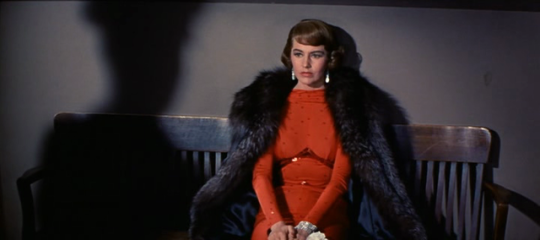
Party Girl (1958) combines the gritty truths of a showgirl’s life with the romantic garishness of MGM; it’s a balancing act between the unbridled machismo of the gangster drama and the lyricism of a musical. To pull off this unique little extravaganza MGM enlisted auteur Nicholas Ray. Ray’s ability to quietly subvert genre and social norms made him the perfect choice to direct Party Girl. Of course, his uncanny ability to effectively use the Cinemascope aspect ratio and Metro-color were also essential considerations.
Though the script, by George Wells, may favor the gangster plot Ray’s direction prioritizes the lyrical spectacle of the musical equally. Leading lady Cyd Charisse gets her two obligatory dance numbers (both staged and photographed beautifully by Ray) but there are also those sequences of montage in Party Girl that posses a musical sensibility even though they do not strictly adhere to the conventions of the genre.
The first such sequence comes during Robert Taylor’s monologue to Charisse about his character’s marriage. The monologue itself is a theatrical performance that Ray sets to a series of images that span the interior of an apartment to a draw bridge at night. The draw bridge illustrates the dialogue and dances through the frame in a wide shot that reinforces the emotional weight of the narrative. Song and dance become monologue and diegetic mechanism.
The second of this type of sequence in Party Girl comes during the European section of the film. Ray shoots a montage of Taylor and Charisse canoodling in cars on different scenic byways and on balconies, beaches or in bistros. No matter where Ray places his stars they are in front of a rear projected image. This montage, with all of its artifice, takes on the plastic wonder of a Minnelli ballet. Here Party Girl is a film of only picture and music, it is MGM at its purest and most decadent.
The Metro-Color process and Cinemascope frame imbue the entirety of Party Girl with this sense of the fantastic. It’s an intoxicatingly grotesque form of realism that allows Ray to unite the disparate aesthetic modes at play in Party Girl. The blood filled tub of a suicide is as deep and radiant as Cyd Charisse’s gown just as Charisse’s graceful limbs and fluid movements are recalled by the draw bridge and the contorting bodies of gunned down gangsters. Party Girl is a film of intersecting fantasies that, while superficially wholly at odds with one another, share a common romantic impulse and morbid fascination with death.
Although Party Girl is set in Chicago during the thirties it is very much a film of the fifties. Like Bigger Than Life (1956), Party Girl attempts to dismantle the dreams and fantasies of bourgeois America. Where Ray was explicit with Bigger Than Life he finds allegory and metaphor for all the same themes in Party Girl. The theme of the paternal figure as self-destructive force is reprised by the mob boss role of Lee J. Cobb while it is the system that fails Charisse rather than her own romantic notions or her lover Robert Taylor. Organized crime and the law itself fills the role that cortisone played in Bigger Than Life just as the ideation of crime is equated with the mental illness in Bigger Than Life.
Party Girl is every bit the masterpiece of Ray’s Bigger Than Life, it simply functions within a different set of parameters and styles. Party Girl sees Nicholas Ray maximized into broad, genre specific gestures beneath which all meaning is hidden. Party Girl is as thematically dense and complex as it is campy, garish and over the top.
